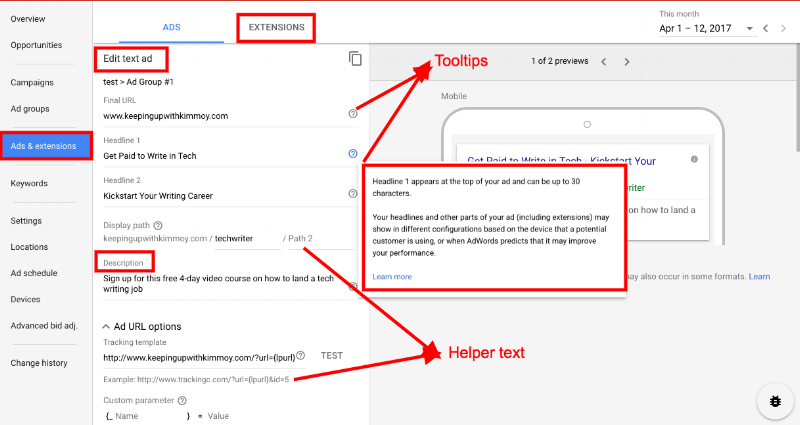As a content strategist/UX writer at Google, my responsibilities were very much similar to a technical writer for a regulatory agency. The land of job titles is quite a tricky one in this field. The audiences, team members, content type, and products can be completely different, but I still go through a particular process for creating and publishing content.
Even though each day is different, I’ll walk you through what I typically do for an upcoming product launch. Keep in mind, I could be jumping in between each step because I own over a dozen product features for Google AdWords, and their launch timelines may overlap.
Learn about the product feature
I’m no expert in Google AdWords, and quite frankly, I don’t have to be, but I do need to know what I’m writing about and most importantly who I’m writing for.
To gain understanding, I schedule meetings with product managers and read their requirements documents to get all the juicy details. I’m also making note of any new content I need to create and existing content I need to update.
Collab with the UX Designer
Being able to see what this new product feature looks like help a lot when writing. The questions I ask during this process are typically what a user would ask as well. I get to collaborate with UX designers and review every single piece of text they’ve written (or not) on the screens. Not only am I learning about how this feature works, but I might be brainstorming the name of a tab or making a list of all the tooltips I need to create to help inform the user.
Brainstorm, draft, and edit
Most of my days are spent editing and writing help center articles, in-product messages, user-interface text, and sometimes marketing content. I find myself referencing style guidelines often and asking my peers a ton of questions so that I’m staying consistent with the voice and tone of the company.
5-star reviews anyone?
During this phase, I’m learning not to take things personally LOL. Red lines, comments, edits are rolling in from the stakeholders. I put on my shield, and this war I’m fighting is on behalf of the user. Ok, that’s a bit dramatic, but it’s true. Marketers might want me to highlight the bells and whistles, legal counsel might expect me to add some CYA legalese, and engineers might want me to mention backend features that explains how it all works. No matter what they all say, I have to ask myself, would it make sense to the user? Is it helpful to them? Do we need to say that? Do we have time for that? lol
Prep content for launch
Once I’ve made it through the review battlefield, it’s time to add the content to a content management system (CMS). A little bit of HTML and CSS knowledge is helpful, but often WYSIWYG works just fine. Again, I’m always referring to resources and my peers to make sure my content is coded up correctly.
Google is the only company I’ve worked for that requires my content to be translated into over 40 languages. This is the phase where I typically have to humble myself and remember that certain things just don’t translate. Keep it simple, sister.
3…2…1…Launch!
This is the most satisfying stage because I’m obsessed with crossing things off my to-do list, but it’s also the most uneventful. Once the content is out there in the world, not much else for me to do really. To be honest, I’m most likely knee-deep in another launch or 4 to take time to celebrate. When you have roughly a dozen babies (product features), you realize they all can’t be superstars at the same time no matter what their parents (product managers)say.
It's all about the user
Whether my title is Content strategist, UX writer, technical writer, tech writer, I know that my work plays a critical role in how a product is understood and used. Confused users don’t stick around, and when users don’t stick around, you lose market share and significant dollars.
I’ve pinched myself several times because to me; this is pretty fun and exciting work:
- How cool is it to brainstorm the name of a button or tab that millions of people are going to use every day?
- How cool is it that when someone sees my article, they can follow the exact steps I wrote and get the job done?
- How badass is it to tell a product manager “Nah bruh, that doesn’t make sense” LOL
In this field, you get to collaborate with engineers, designers, marketers, researchers, and product managers to help users. If you’re interested in getting your feet wet in this field, I invite you to explore my other blog posts and sign up for my free e-course for tips on how to get a tech writing job.














